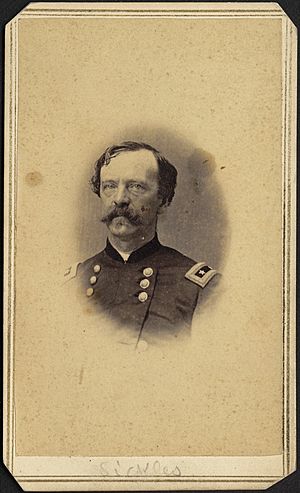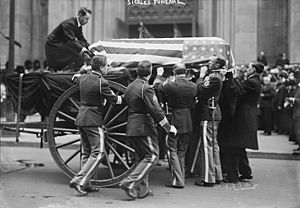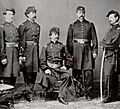Daniel Sickles facts for kids
Quick facts for kids
Daniel Sickles
|
|
|---|---|

Major General Sickles c. 1862
|
|
| Member of the U.S. House of Representatives from New York |
|
| In office March 4, 1893 – March 3, 1895 |
|
| Preceded by | William Bourke Cockran |
| Succeeded by | Amos J. Cummings |
| Constituency | 10th district |
| In office March 4, 1857 – March 3, 1861 |
|
| Preceded by | Guy R. Pelton |
| Succeeded by | Benjamin Wood |
| Constituency | 3rd district |
| United States Minister to Spain | |
| In office May 15, 1869 – January 31, 1874 |
|
| President | Ulysses S. Grant |
| Preceded by | John P. Hale |
| Succeeded by | Caleb Cushing |
| Member of the New York Senate from the 3rd district |
|
| In office January 1, 1856 – March 3, 1857 |
|
| Preceded by | Thomas J. Barr |
| Succeeded by | Francis B. Spinola |
| Personal details | |
| Born | October 20, 1819 New York City, US |
| Died | May 3, 1914 (aged 94) New York City, US |
| Resting place | Arlington National Cemetery |
| Political party | Democratic |
| Spouses |
Teresa Bagioli Sickles
(m. 1852; died 1867)Carmina Creagh
(m. 1871) |
| Children | 3 |
| Nickname | "Devil Dan" |
| Military service | |
| Allegiance | United States Union |
| Branch/service | United States Army Union Army |
| Years of service | 1861–1869 |
| Rank | Major general |
| Commands | Excelsior Brigade III Corps |
| Battles/wars | American Civil War |
| Awards | Medal of Honor |
Daniel Edgar Sickles (October 20, 1819 – May 3, 1914) was an important American figure. He was a politician, a soldier, and a diplomat.
When the American Civil War began in 1861, Sickles became a well-known general. He helped gather New York soldiers for the Union Army. These soldiers became part of the Excelsior Brigade. Even though he didn't have much military training, he led troops in several early battles.
His military career mostly ended at the Battle of Gettysburg in July 1863. During this battle, he moved his III Corps to a new spot without orders. This move led to many casualties for his troops. Sickles was badly wounded by a cannonball and lost his leg. He later received the Medal of Honor for his bravery.
After the war, Sickles worked to get credit for the Union victory at Gettysburg. He wrote articles and spoke to Congress. He even criticized his commanding officer, Maj. Gen. George Meade. Sickles also served as a commander in the South during Reconstruction. Later, he became the U.S. Minister to Spain. He was re-elected to Congress and helped create the Gettysburg Battlefield park.
Contents
Daniel Sickles: A Life of Service
Early Life and Political Beginnings
Daniel Sickles was born in New York City in 1819. His father, George Garrett Sickles, was a lawyer and politician. Daniel learned the printing trade and studied at the University of the City of New York. He later studied law and became a lawyer in 1846. The next year, he was elected to the New York State Assembly.
In 1852, Sickles married Teresa Bagioli. She was about 15 or 16 years old at the time. Teresa was very smart and could speak five languages.
In 1853, Sickles became a city lawyer for New York City. Soon after, he became a secretary for the U.S. government in London. This job was given to him by President Franklin Pierce. He returned to the United States in 1855. In 1856, he was elected to the New York State Senate. He was also elected to the U.S. Congress as a Democrat. He served in Congress from 1857 to 1861.
A Difficult Time
In 1859, Daniel Sickles was involved in a very serious event. He shot and killed Philip Barton Key II in Lafayette Square. Key was a lawyer for the District of Columbia.
Sickles was charged with murder. He had several important politicians help him with his defense. One of them was Edwin M. Stanton, who later became Secretary of War. Sickles was found not guilty. His lawyers used a new legal defense called "temporary insanity." This was the first time this defense was used in U.S. history. After the trial, Sickles took a short break from public life.
Joining the Civil War
Before the Civil War, Sickles was part of the New York Militia. He was a major and liked to wear his uniform. When the Civil War started, Sickles wanted to improve his public image. He helped raise volunteer soldiers in New York for the Union Army. Because of his political connections, he was made a colonel. He led one of the four regiments he organized. In September 1861, he was promoted to brigadier general.
Sickles was known for his actions regarding runaway slaves. He refused to send them back to their owners. Instead, he hired many of them as servants. He even trained some male slaves to be soldiers. This policy was supported by a powerful committee in Congress.
In March 1862, Sickles had to give up his command. Congress did not confirm his promotion. He used his political connections to get his rank back. He rejoined the army in May 1862. This was just in time for the Peninsula Campaign. He missed some battles, but he did a good job leading his "Excelsior Brigade" in other fights. He was not present for the Second Battle of Bull Run or the Battle of Antietam.
Sickles was a close friend of Maj. Gen. Joseph Hooker. Both men were known for trying to advance their careers.
Sickles' troops were held back during the Battle of Fredericksburg. In January 1863, President Abraham Lincoln nominated Sickles for promotion. He became a major general in March 1863. Hooker, who was now leading the Army of the Potomac, gave Sickles command of the III Corps. This was unusual because Sickles was the only corps commander without a West Point military education.
The Battle of Chancellorsville
Sickles showed great energy and skill at the Battle of Chancellorsville. He wanted to chase after Confederate troops he saw on May 2, 1863. Sickles thought the Confederates were retreating. But these were actually parts of Stonewall Jackson's army. They were secretly marching around the Union side. Sickles also strongly disagreed with Hooker's orders to move his troops off good defensive ground. In both cases, if Hooker had listened to Sickles, the battle might have turned out differently for the Union.
The Battle of Gettysburg
The Battle of Gettysburg was the most famous part of Sickles' military career. On July 2, 1863, Maj. Gen. George Meade, the Union commander, ordered Sickles' corps to defend Cemetery Ridge. Sickles was not happy with his position. He saw a slightly higher area called the "Peach Orchard" in front of him. So, he decided to move his troops forward to the Peach Orchard. This was almost a mile in front of Cemetery Ridge.
This move spread his troops out too much. It also created a weak spot that could be attacked from many sides. Meade soon found out about Sickles' move. He rode to Sickles' position and explained the mistake. Meade could not order Sickles to move back. It was too late, and the Confederates were about to attack. Moving retreating troops would be even more dangerous.
The Confederates attacked soon after Meade spoke with Sickles. Lt. Gen. James Longstreet's Confederate corps attacked Sickles' III Corps. The attack badly damaged the III Corps. Historians say Sickles' move caused many problems for the Union line. However, some historians also say Sickles' move accidentally helped the Union. It surprised the Confederates and changed their attack plans. This may have stopped the Confederate plan to break the Union line.
During the attack, Sickles was hit by a cannonball. He was carried to a nearby farmhouse. His leg was amputated that afternoon. He insisted on being taken to Washington, D.C.. He arrived there on July 4, 1863. He brought some of the first news of the Union victory. He also began trying to defend his actions in the battle. President Lincoln visited General Sickles in Washington on July 5.
After Gettysburg, Sickles often criticized General Meade. Sickles felt that Meade had treated him unfairly. He also believed he deserved credit for winning the battle. He wrote anonymous newspaper articles and spoke to Congress. He falsely claimed that Meade had planned to retreat from Gettysburg. He also said he had occupied Little Round Top on July 2. Sickles always argued that his move was correct. He said it disrupted the Confederate attack and protected the Union's main goals. Historians still debate the effects of Sickles' actions.
Sickles eventually received the Medal of Honor for his actions. It took him 34 years to get it. The award recognized his "most conspicuous gallantry." It noted he fought bravely and encouraged his troops even after being wounded.
After the War: A New Chapter
Even though he lost a leg, Sickles stayed in the army until the war ended. He was disappointed that Lt. Gen. Ulysses S. Grant would not let him return to combat. In 1867, he received honorary promotions to brigadier general and major general. These were for his service at Fredericksburg and Gettysburg.
After the Civil War, in 1865, Sickles went on a secret mission to Colombia. He helped make sure Colombia followed a treaty. This treaty allowed the United States to move troops across the Isthmus of Panama. From 1865 to 1867, he commanded military districts in the South. Sickles worked to ensure fair treatment for African-Americans. He also protected the rights of workers. He stopped property foreclosures and made sure farm workers' wages were paid first. He also made discrimination against African-Americans illegal.
In 1869, he retired from the army as a major general.
Sickles served as the U.S. Minister to Spain from 1869 to 1874. He was involved in talks about the Virginius Affair. His messages to Washington were sometimes emotional and pushed for war. However, Secretary of State Hamilton Fish took over the main talks. This helped prevent a war.
In 1871, after his first wife Teresa died, Sickles married Carmina Creagh. She was from Madrid, Spain. They had two children together.
Helping Preserve History

From the 1880s until near the end of his life, Sickles often attended Gettysburg reunions. He was popular with many of the veterans who served under him. He also became friends with James Longstreet, a former Confederate general. Longstreet was also trying to defend his actions during the war. However, not all veterans liked Sickles. This was because he often claimed too much credit for the Union victory. He also kept attacking George Meade, even after Meade died in 1872.
In 1886, the New York Monuments Commission was formed. Sickles was made its honorary chairman. He worked hard for the rest of his life to get money for monuments. These monuments honored New York regiments, artillery units, and commanders. He made sure they were placed correctly on the Gettysburg battlefield. However, he was forced to leave the Commission in 1912. This happened when $27,000 was found to have been stolen.
Sickles also served as chairman of the New York State Civil Service Commission from 1888 to 1889. In 1890, he became the Sheriff of New York County. In 1891, he joined the board of the Gettysburg Battlefield Memorial Association. In 1892, he was elected to Congress again. He served from 1893 to 1895.
As a congressman, Sickles played a big part in preserving the Gettysburg Battlefield. He supported laws to create the Gettysburg National Military Park. He helped buy private lands and put up monuments. He even got the original fences from Lafayette Square to mark the park's borders. The park's boundaries were based on a map Sickles made until 1974.
Most of the main generals who fought at Gettysburg have statues. But Sickles does not have one. When asked why, he supposedly said, "The entire battlefield is a memorial to Sickles." The monument for the New York Excelsior Brigade was supposed to have a statue of Sickles. Instead, it has a figure of an eagle.
Later Life and Legacy
Daniel Sickles lived the rest of his life in New York City. He died on May 3, 1914, at the age of 94. He passed away from a cerebral hemorrhage. His funeral was held at St. Patrick's Cathedral in Manhattan. He was buried in Arlington National Cemetery.
In Popular Culture
- American Scoundrel: The Life of the Notorious Civil War General Dan Sickles is a book about him by Thomas Keneally.
- Sickles appears in the alternate history novels Gettysburg: A Novel of the Civil War (2003) and Grant Comes East (2004). These are the first two books of a Civil War series.
- In Stephen L. Carter's 2012 novel, The Impeachment of Abraham Lincoln, Sickles is one of the lawyers defending Lincoln.
- A copy of Sickles' leg is shown briefly in the 2012 movie Lincoln.
- The story of Philip Barton Key's death was covered in a 2019 episode of the Unresolved podcast.
- The Battle of Gettysburg Podcast often features a "Sickles Report." Episodes 3 and 4 of its second season were about Sickles' actions and their link to Gettysburg. The podcast also discussed the battle for the Peach Orchard. Jim Hessler, who wrote a book called Sickles at Gettysburg, is a co-host of this podcast.
- Gettysburg's official podcast, Addressing Gettysburg, often discusses Daniel Sickles. Author and Licensed Battlefield Guide Jim Hessler has appeared on the show many times. One episode (released January 3, 2021) was all about Daniel Sickles' life. [1]
Images for kids
-
Sickles funeral in Manhattan on May 8, 1914








